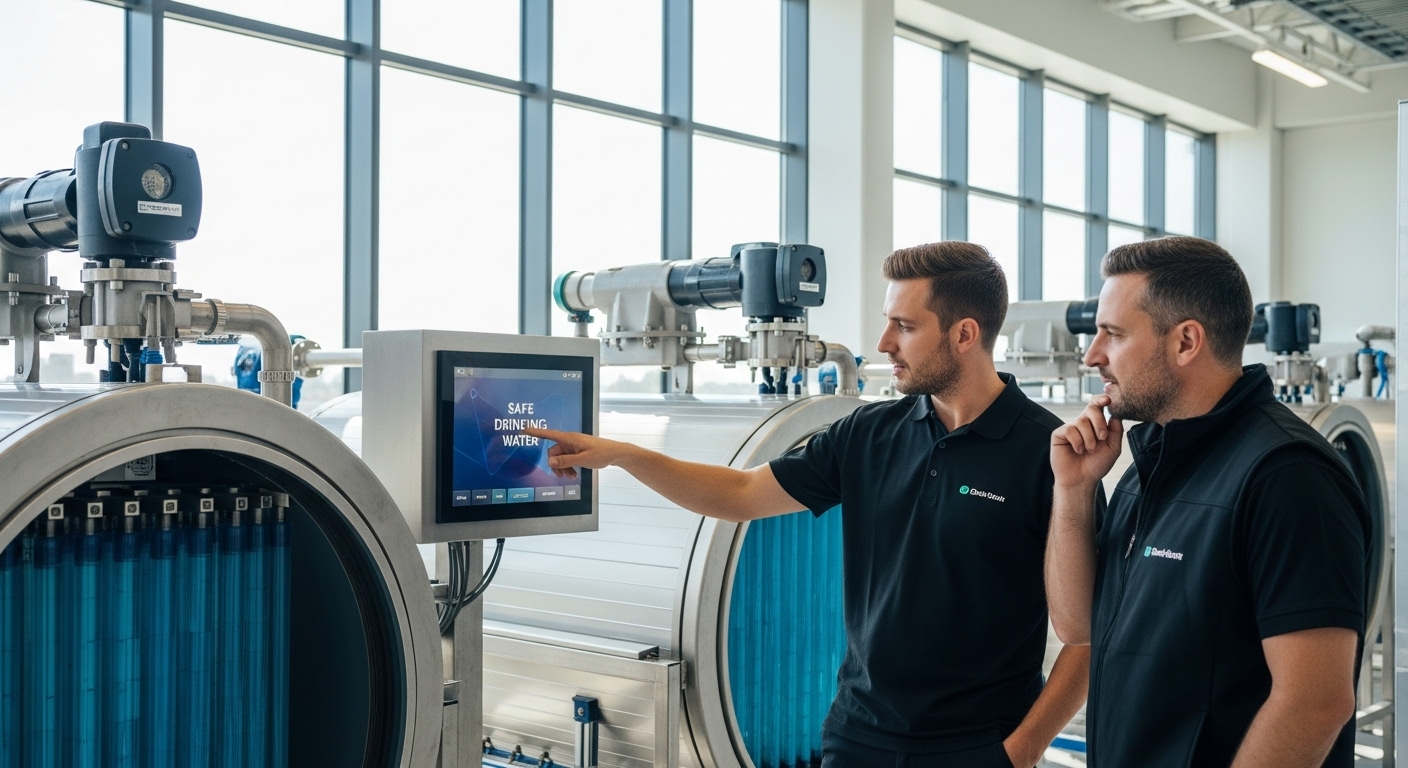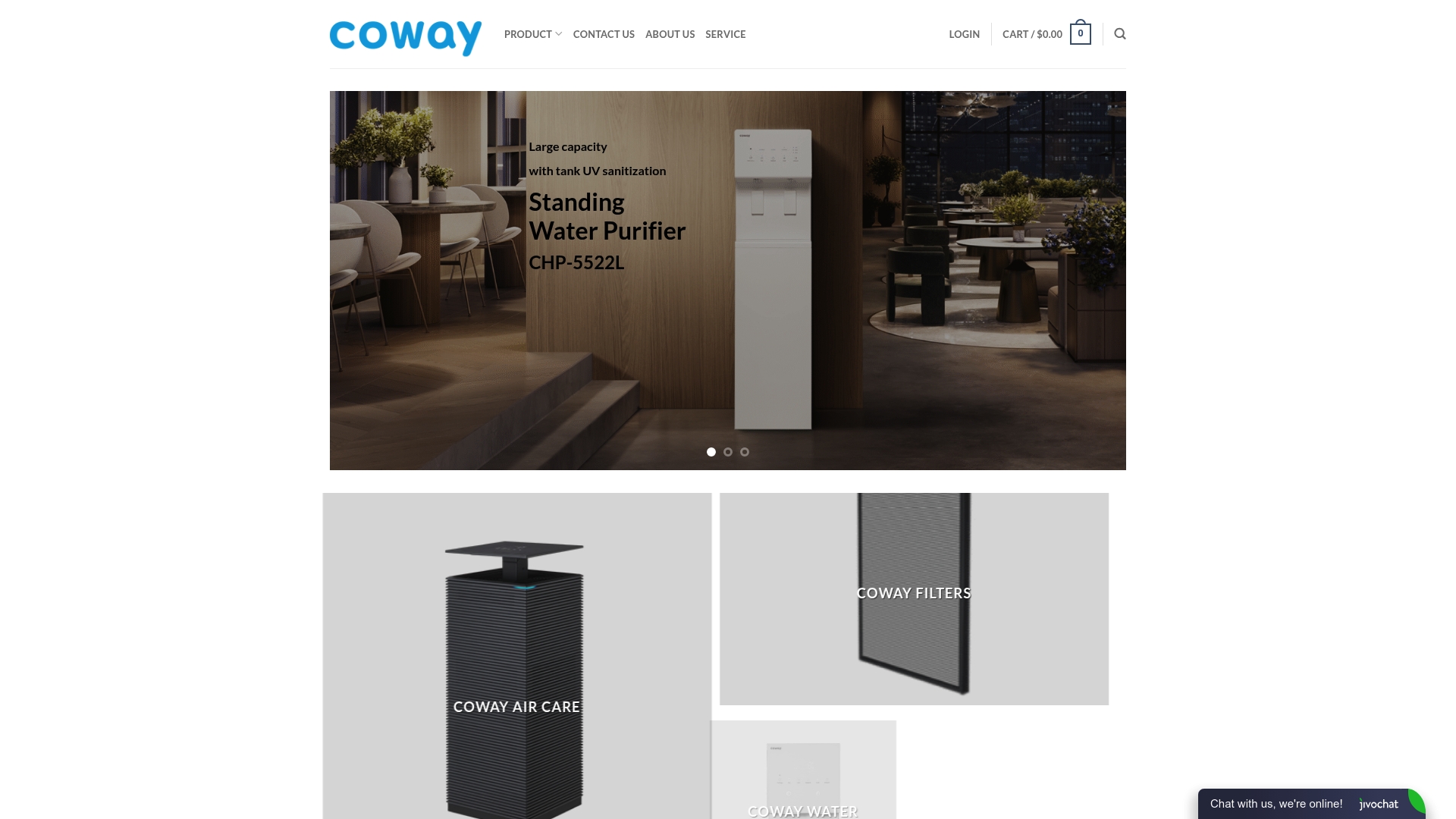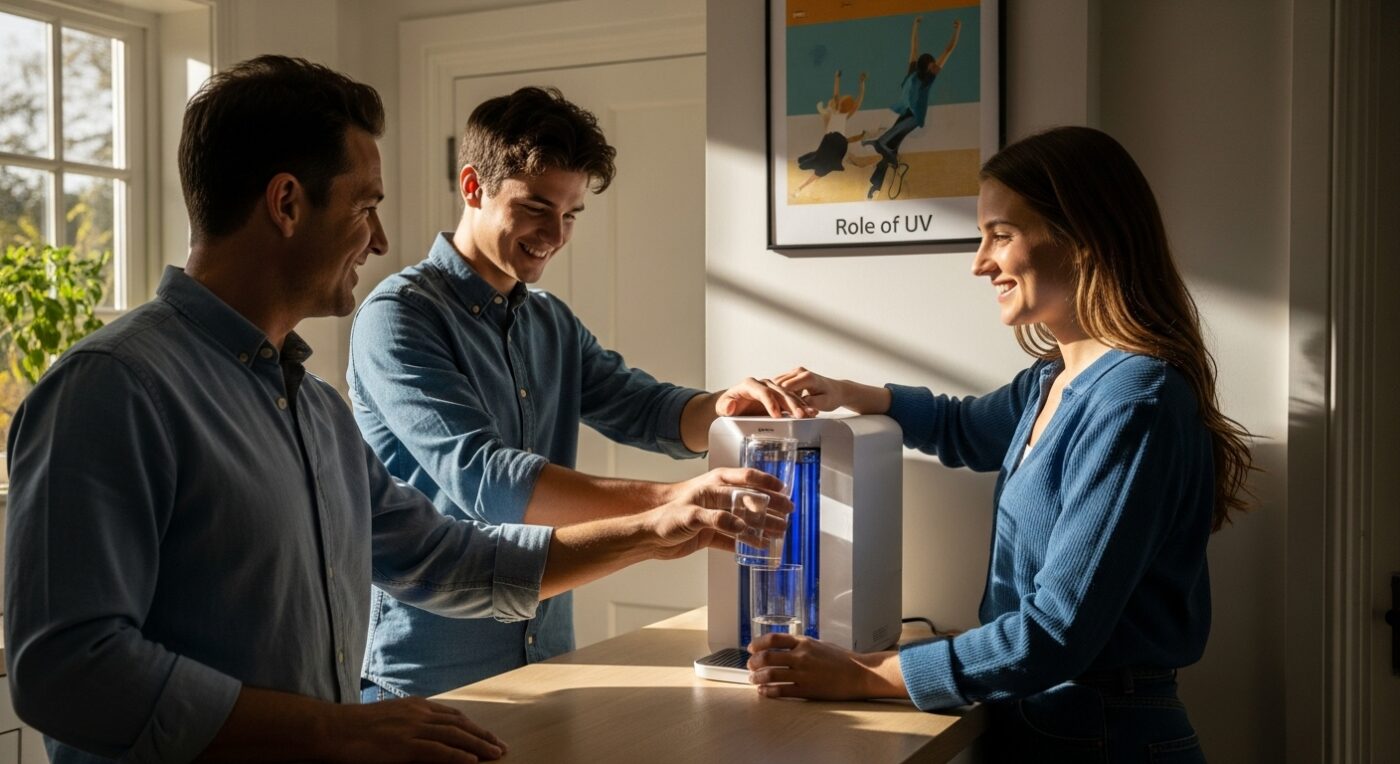Uncategorized
Understanding the Role of UV in Water Purification
UV water purification sounds high tech, right? It uses powerful ultraviolet rays to zap away harmful microbes in just seconds. But most people are shocked to learn that UV treatment eliminates bacteria and viruses without adding a single drop of chemicals. That flips the script on what we expect from clean water technology.
Table of Contents
- What Is Uv Water Purification And How Does It Work?
- Why Uv Technology Matters For Safe Drinking Water
- Key Concepts Behind Uv Water Purification
- Real-World Applications Of Uv In Water Treatment
- Comparing Uv Purification To Other Water Treatment Methods
Quick Summary
| Takeaway | Explanation |
|---|---|
| UV purification eliminates pathogens effectively | It targets DNA and RNA, destroying microorganisms rapidly to ensure safe drinking water. |
| No chemicals are introduced during treatment | Unlike chlorine methods, UV purification maintains water’s natural taste without residual contaminants. |
| Water clarity impacts UV effectiveness | High turbidity can hinder UV light penetration, making pre-filtration crucial for optimal results. |
| Combined methods enhance water safety | Using UV with other filtration techniques creates a comprehensive approach for ensuring clean water. |
| Broad application across industries | UV technology is versatile, used in municipal systems, pharmaceuticals, and food production for reliable purification. |
What is UV Water Purification and How Does It Work?
Ultraviolet (UV) water purification represents an advanced technological approach to eliminating harmful microorganisms from water without introducing additional chemicals. This scientific method leverages specific wavelengths of light to neutralize potentially dangerous pathogens, providing a clean and safe water treatment solution.
The Science Behind UV Water Purification
UV water purification operates on a fascinating principle of molecular disruption. When water passes through a UV light chamber, the ultraviolet rays penetrate the cellular structures of microorganisms like bacteria, viruses, and protozoa. These powerful light waves specifically target the genetic material (DNA and RNA) within these microbes, causing irreparable damage that prevents them from reproducing or functioning.
According to the Mortenson Center in Global Engineering & Resilience, UV light technology inactivates pathogens by fundamentally destroying their ability to replicate. This process happens within seconds, making it an incredibly rapid and efficient water treatment method.
Key Advantages of UV Water Treatment
UV water purification offers several significant benefits that make it an attractive water treatment option:
- Chemical Free: Unlike traditional chlorine-based treatments, UV purification does not introduce any additional chemicals into the water
- Rapid Elimination: Neutralizes microorganisms almost instantaneously
- Taste Preservation: Maintains the natural taste and odor of water
While extremely effective, UV treatment works best when combined with other filtration methods. Read more about comprehensive water purification techniques to understand how UV fits into a complete water safety strategy.
The technology’s effectiveness depends on multiple factors including UV lamp intensity, water clarity, and exposure time. Water with high turbidity or significant particulate matter can reduce UV light penetration, which is why pre filtration is often recommended to maximize the purification process.
Why UV Technology Matters for Safe Drinking Water
In an era where water quality is increasingly critical, UV technology emerges as a powerful solution for ensuring safe and clean drinking water. This advanced purification method addresses significant public health challenges by effectively neutralizing harmful microorganisms that traditional treatment methods might miss.
The Critical Role of Pathogen Elimination
Waterborne pathogens pose substantial risks to human health, potentially causing severe illnesses ranging from mild gastrointestinal issues to life threatening conditions. UV technology provides a robust defense mechanism against these microscopic threats. Research from the Wilderness Medical Society confirms that at sufficient radiation doses, UV can inactivate virtually all waterborne enteric pathogens, making it an exceptional water treatment strategy.
Advantages Beyond Traditional Disinfection
UV water purification offers several compelling advantages that distinguish it from conventional chemical treatment methods:
- Immediate Microbial Inactivation: Destroys harmful microorganisms within seconds
- No Chemical Residue: Eliminates contaminants without introducing additional chemicals
- Broad Spectrum Protection: Effective against bacteria, viruses, and protozoan parasites
Understanding the broader context of water treatment is crucial. Learn more about comprehensive water purification strategies to appreciate how UV technology fits into holistic water safety approaches.
Moreover, UV technology represents a scientifically validated method that meets rigorous public health standards. Its non invasive nature and ability to provide consistent protection make it an increasingly preferred choice for residential and commercial water treatment applications. By targeting the genetic material of microorganisms, UV technology ensures that potential pathogens cannot reproduce or cause infection, providing a critical layer of defense in our ongoing battle for safe drinking water.

Key Concepts Behind UV Water Purification
UV water purification is a sophisticated technological approach that harnesses specific light wavelengths to eliminate harmful microorganisms. Understanding its fundamental principles requires exploring the intricate scientific mechanisms that make this water treatment method so effective.
Wavelength and Molecular Interaction
The core of UV water purification lies in its precise electromagnetic radiation. Ultraviolet light waves between 200 and 300 nanometers, specifically peaking around 260 nanometers, possess unique properties that enable them to penetrate and disrupt microbial cellular structures. According to research from the Mortenson Center, these specific wavelengths target the nucleic acids of microorganisms, preventing their ability to replicate and causing immediate inactivation.
Critical Operational Parameters
Several key factors determine the effectiveness of UV water purification:
- Radiation Intensity: Higher UV light intensity increases pathogen elimination rates
- Water Clarity: Clearer water allows better light penetration and more effective treatment
- Exposure Duration: Longer contact time with UV light ensures comprehensive microbial inactivation
Learn more about comprehensive water treatment technologies to understand how UV fits into broader purification strategies.
The technological landscape of UV water purification continues to evolve, with emerging innovations like UV LED devices offering more precise and energy efficient alternatives to traditional mercury vapor lamps.
This table outlines the critical operational parameters that impact the effectiveness of UV water purification, providing a quick reference for understanding the key factors at play.
| Parameter | Impact on UV Purification Effectiveness |
|---|---|
| Radiation Intensity | Higher UV intensity increases pathogen elimination rates |
| Water Clarity | Clearer water allows better light penetration and more effective treatment |
| Exposure Duration | Longer contact time ensures comprehensive microbial inactivation |
| These advancements promise enhanced point of use applications and greater flexibility in water treatment approaches, making UV technology an increasingly sophisticated solution for ensuring water safety. |
Real-World Applications of UV in Water Treatment
Ultraviolet water treatment technology has expanded far beyond laboratory settings, becoming a critical solution across multiple sectors addressing water quality challenges. From municipal water systems to specialized industrial applications, UV technology offers versatile and effective water purification strategies.
Municipal Water Treatment Systems
Municipal water treatment facilities increasingly integrate UV technology as a reliable disinfection method. Unlike traditional chlorine treatments, UV systems provide rapid pathogen elimination without introducing chemical residues. Research from the University of Colorado Boulder confirms that UV treatment effectively neutralizes waterborne pathogens within seconds, making it an essential component of modern urban water infrastructure.
Industrial and Specialized Applications
UV water purification demonstrates remarkable versatility across various industrial contexts:
- Pharmaceutical Manufacturing: Ensures ultra pure water for sensitive production processes
- Food and Beverage Production: Eliminates microbiological contamination without altering taste
- Semiconductor Manufacturing: Provides high precision water treatment for delicate manufacturing requirements
Explore comprehensive water filtration techniques to understand how UV technology integrates with broader water treatment strategies.
Emergent applications continue to expand, with researchers developing innovative UV treatment methods for challenging scenarios like agricultural runoff and wastewater management. The technology’s ability to destroy genetic material of microorganisms without producing harmful byproducts positions it as a sustainable and forward thinking solution for global water safety challenges.
Comparing UV Purification to Other Water Treatment Methods
Water treatment technologies vary widely in their approaches, effectiveness, and environmental impact. Understanding how UV purification compares to alternative methods helps consumers and professionals make informed decisions about water safety and treatment strategies.
Chemical vs. Non Chemical Disinfection
Traditional chemical disinfection methods like chlorination have long been the standard for water treatment. However, UV purification offers a fundamentally different approach. According to the Agency for Toxic Substances and Disease Registry, while chemical treatments introduce additional substances into water, UV light provides a non chemical alternative that eliminates microorganisms without creating potentially harmful disinfection byproducts.
Comparative Performance Characteristics
Each water treatment method presents unique strengths and limitations:
-
UV Purification
- Rapidly inactivates microorganisms
- No chemical residue
- Environmentally friendly
-
Chlorination
- Provides long term residual protection
- Effective against wide range of pathogens
- Can alter water taste
-
Reverse Osmosis
- Removes dissolved solids
- Comprehensive filtration
- Requires significant energy and maintenance
Explore comprehensive water filtration techniques to understand the nuanced landscape of water treatment technologies.
While no single method represents a perfect solution, UV purification stands out for its ability to provide rapid, chemical free disinfection.
Below is a comparison table summarizing the main features, benefits, and limitations of UV purification, chlorination, and reverse osmosis as discussed in the article.
| Method | Main Advantages | Limitations/Considerations | Chemical Use |
|---|---|---|---|
| UV Purification | Rapid microbial inactivation; no chemical residue; preserves taste | Requires pre-filtration for clarity; does not remove dissolved solids | No |
| Chlorination | Long-lasting residual protection; effective against many pathogens | Can alter taste; may produce byproducts | Yes |
| Reverse Osmosis | Removes dissolved solids; comprehensive filtration | High energy and maintenance needs; can waste water | No (but may use other filters) |
Its primary limitation involves water clarity effectiveness technical professionals recommend pre filtration to enhance performance in turbid water conditions. As water treatment technologies continue evolving, integrated approaches combining multiple methods are increasingly becoming the gold standard for comprehensive water safety.
Upgrade Your Home to the Gold Standard of Water Safety
If you have been learning about the importance of UV water purification in protecting your family from harmful microorganisms, you already know how crucial reliable technology really is. The article highlights real concerns about chemical-free disinfection, effective pathogen removal, and keeping water pure without altering taste. But simply understanding these risks is not enough—taking real steps to ensure safer water at home is what matters most. For a deeper dive into solutions and expert advice, visit our Uncategorized section for current trends and tips on water wellness.

Now is the perfect time to bring advanced purification into your home. Explore our full range of Coway water purifiers, featuring powerful UV technology and multi-stage filtration for real peace of mind. Combining science-backed performance and hassle-free service, we make it easy to choose a healthier lifestyle. Take control of your water quality at https://cowayswaterpurifier.com and start enjoying the benefits of technology designed to protect your loved ones today.
Frequently Asked Questions
What is UV water purification?
UV water purification is a method that uses ultraviolet light to eliminate harmful microorganisms from water without adding any chemicals. It targets and disrupts the genetic material of pathogens, ensuring safe drinking water.
How does UV water purification work?
When water passes through a UV light chamber, ultraviolet rays penetrate microorganisms such as bacteria and viruses, damaging their DNA and preventing replication, which leads to their inactivation within seconds.
What are the advantages of using UV water purification?
UV water purification offers several benefits including rapid microbial inactivation, no chemical residues in the water, and preservation of the water’s taste and odor, making it an efficient and environmentally friendly treatment method.
Does UV purification require pre-filtration?
Yes, UV purification is most effective when combined with pre-filtration. Water with high turbidity or particulate matter can reduce UV light penetration, so ensuring clear water enhances the purification process.
Recommended
- 7 Effective Water Purification Methods for Your Home – Coway Water Purifier
- What is Water Purification? Understanding Its Importance – Coway Water Purifier
- Understanding Air vs Water Purifiers: Key Differences Explained – Coway Water Purifier
- What is Water Filtration? Understanding Its Importance – Coway Water Purifier
- Understanding Water Sanitizers – ClearSpa™

